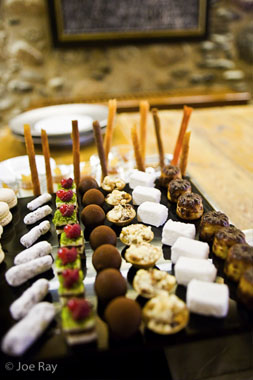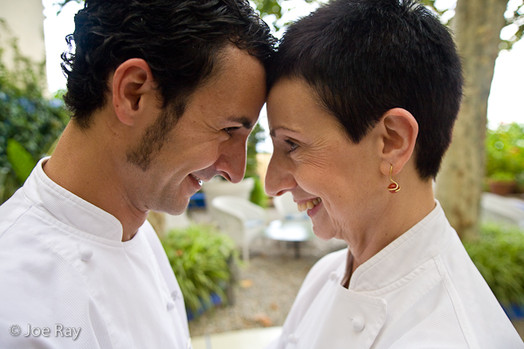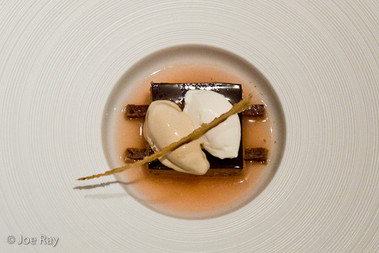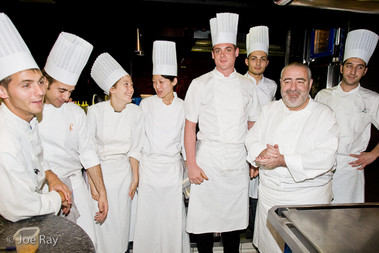The Centurion Menu - Carme Ruscalleda & Santi Santamaria
December 2008 - Centurion Magazine

Barcelona Over the past decade, Catalan chef Ferran Adrià has turned the food world on its head with creations like spherifications, essences and gels. Shockwaves of his influence – a cuisine he’s perfected called ‘molecular gastronomy’ – rippled around the world. Catalan and Spanish cuisine got an incredible boost and chefs here have both risen to the challenge and rode the wave. It has created an inescapable, contagious excitement about food in Spain that the French can only dream about.
Fellow Catalans and Michelin three-star chefs, Santi Santamaria of Raco de Can Fabes, in Sant Celoni, and Carme Ruscalleda of Restaurant Sant Pau in Sant Pol de Mar, are both understandably closer to classic Catalan than Adrià ’s otherworldly offerings, but are each doing their distinct best, basing their work on magnificent, pure presentations of local ingredients.
Each chef offers a unique and delicious definition when asked, ‘What is Catalan cuisine?’ Ruscalleda, who thrust herself into the spotlight in 2005 when she became Spain’s first female three-star chef (she also has two Michelin stars for the Tokyo version of Sant Pau), tweaks her definition every time she stands behind the stove or considers what to highlight in her frequent menu changes. Santamaria, who has a total of six Michelin stars including the three at his Can Fabes home base, forced the question when he unleashed a media firestorm in early 2008, attacking Adrià and Spain’s new wave.
Exclusively for Centurion readers, the chefs have conceived the Centurion Menu around three typical ingredients chosen by Ruscalleda: zucchini flowers, gambas (prawns) and chocolate. Product selection isn’t much of a stretch for Ruscalleda, who comes from an agricultural family in the town of Sant Pol de Mar, about 50km up the coast from Barcelona – for her, food has always played a central role.
“We didn’t have a TV,†she says, recalling her youth. “We had food and we talked about it. Everyone worked hard. Everyone did their part. I come from a generation where we helped out at home. Today, if a parent told their 12-year old to cook dinner, they’d scream child exploitation.â€
Instead, the self-taught Ruscalleda relished the experience. “My training is domestic, but I sold and grew vegetables and meat. I learned everything from my mother,†she explains. Now, continuing the family tradition, she is joined in the kitchen by her son, Raul.
 Carme Ruscalleda with her son Raul in the garden of Restaurant Sant Pau in Sant Pol de Mar, Spain.Photo by Joe Ray
Carme Ruscalleda with her son Raul in the garden of Restaurant Sant Pau in Sant Pol de Mar, Spain.Photo by Joe RayRuscalleda also had an artistic side to nourish. At 16, she taught herself the art of charcuterie. “I learned to kill pigs at home,†she says, playfully flaunting skills few chefs at any level possess. “I discovered that I could do classic sausages and more adventurous ones and people liked those, too. This is what opened the door for me.â€
Her artistic side might now be most evident in what she calls ‘squid 2008 with five flavours’, where flavours are distributed across the protein in gelatin packets that are a gentle wink to Ferran Adrià , each containing liquid distillations of tastes like tomato, red pepper or squid ink, each bite different.
This love, understanding and appreciation of the product is evident in Ruscalleda’s ingredient choices. “The gamba is the princess of the sea,†she says, as if playfully referring to a fellow member of royalty. “In the kitchen we only use masculine zucchini flowers,†which are slightly smaller and grow on the plant stem, “they have the right form and nutrients.â€
And the chocolate? She grins. “All women love chocolate.â€
The real fun comes in seeing what Ruscalleda does with her products. Her deceptively simple ‘zucchini flower in tempura’ dish is encased in a nearly invisible tempura batter and dusted with gold flakes. Its ‘liquid stuffing’ combines Catalan classics like blood sausage, pumpkin and zucchini, which ooze from its floral wrapper only when cut.
Carme Ruscalleda lets loose in the garden of Restaurant Sant Pau. Photo by Joe RayHer ‘gamba omelette’ is a nib of pa amb tomà quet – garlicrubbed, olive oil-coated tomato bread – rolled into an ultra-thin omelette. Beneath it, a pink sauce made from roe, all topped with one perfect, finger-sized gamba with fiery red stripes.
The chocolate she loves is part of a well-thought-out dessert simply called ‘bitter’ – coffee, chocolate, hazelnuts and citrus ice cream, each lending different forms of bitterness and acidity, all floating above a pool of grapefruit juice. It’s the perfect follow up to a cheese course and a sumptuous meal.
Santi Santamaria, on the other hand, is an altogether different proposition.
While Senyora Ruscalleda is the gentle teacher who wins your heart by sliding edible art under your nose, the Can Fabes chef is a Spanish bull in a china shop. He is also a man on a mission – the Catalan version of activist French farmer José Bové. He knows what he likes about his food and what he doesn’t like about other styles of cuisine.
While Bové literally drove a tractor into a French McDonald’s restaurant, Santamaria has been driving a figurative one through Spain’s new wave of cuisine for the past year. He is both a protectionist and a predator, a genius and a manipulator, a relentless self-promoter; you will know what he thinks whether it’s through your mouth or your ears and after a long interview, I can’t decide if I want to hug the man or hit him.
Among other wildly provocative statements, in early 2008, he accused Ferran Adrià and his camp of poisoning diners by using ingredients such as methylcellulose to help create gels and emulsions. This went down like a lead balloon in Spanish gastronomic circles, causing hundreds of back-bitten chefs to sign a protest letter.
 ‘Bitter dessert’. Photo by Joe Ray
‘Bitter dessert’. Photo by Joe Ray“We learn to cook from our parents and we’re at the point of major change,†he says, undaunted.“We have to respect our products. I have to denounce these things.â€
You get the sense that his take on the world has been shaken to the core by Spain’s new wave and now he’s lashing out, but when we spoke, he did show a bit of soul beneath the hot air.
“There’s a time where chefs have to say, ‘This doesn’t go on a plate,’ and we have to ask what kind of society we want,†he says, defending his attacks. “I don’t have problems with other chefs – I’m talking about food and morals.â€
His methods can be brutish – his is a very blunt instrument – but he’s also forcing the thinking gastronome to question everything they put in their mouth. Is this good? Is it worth it? Why? Plus, the person he raises the bar for the most is himself, a challenge he relishes.
Curiously, Santamaria wants change. More specifically, he wants progress, but his vision of progress is linear, not the parabolic rise Spain has seen in the last several years. He may serve cockles in a ginger broth, leaving the tiny bivalves blissfully untouched, but unlike Ruscalleda, it will be a cold day in hell before he makes any on-plate references to Ferran Adrià .
The dish also reveals Santamaria’s strict adherence to product primacy. “You can’t make an oyster more perfect,†he exclaims, exhibiting restraint in one of his favourite ingredients. “The chef’s job isn’t to dominate. We must just understand. Usually, we have fantastic local mushrooms. This year, there aren’t as many, but there’s no way I’m going to import them.
 Santi Santamaria, sans toque in the kitchen of restaurant Raco de Can Fabes. Photo by Joe Ray
Santi Santamaria, sans toque in the kitchen of restaurant Raco de Can Fabes. Photo by Joe Ray “A menu must always be a function of time – it’s got to go with the seasons.†He uses what his local farmers and fishermen can provide; this is what he knows and he will fight for.
His choices for what to do with the Centurion Menu ingredients reflect and flaunt this primacy. His ‘zucchini flower with cheese’ is a perfect example of this. Even in their fleeting season, the flowers are incredibly temperamental – available one day, closed up and off the market due to foul weather the next.
Storage tends not to be much of a problem – if you get them in the morning, you serve them that evening or you throw them on the compost heap. On the plate, they are presented both cooked and uncooked to flaunt their beauty, stuffed with fresh cheese.
He creates ravioli with gambas, or more precisely, ravioli from gambas – replacing the pasta with thin slices of the crustacean and surrounding it with a mushroom sauce that has bubbled away in the oven for an astounding twelve hours. His chocolate beignets are traditionally a cream-filled Easter dessert in his homeland, but chocolate is the star this time, stealing the show when each beignet’s tiny orb is broken and the molten chocolate truffle slowly works its way across the plate.
“The kitchen is a living organism,†Santamaria states, before adding, “Discussing is good. I don’t want to sleep through this – I want to fight,†he says, taking a bite of cured meat and sipping vermouth, “This is good. If I like it, I say it. I feel alive.†- Joe Ray
See the .pdf version of this story - with recipes - as it ran in Centurion Magazine here